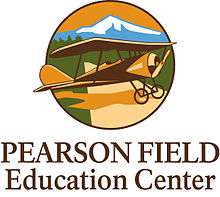Pearson Field Education Center
Coordinates: 45°37′23″N 122°39′18″W / 45.623°N 122.655°W

The Pearson Field Education Center[1] (PFEC) delivers experiential aviation based science, technology, engineering and math (STEM) programs for young people ages kindergarten through 12th grade (K-12) on historic[2] Pearson Field, Vancouver, Washington. Knowledge and experience gained at PFEC provides a foundation for young people’s further education and careers in STEM based fields, including aviation, while instilling an appreciation for those that have gone before them and the history of Pearson Field. PFEC's mission is to "Educate, inspire and promote the golden age of aviation at Pearson Field."
History
PFEC began in the spring of 2013 as a program of the Fort Vancouver National Trust[3] (FVNT), a 501(c)(3) nonprofit since 1998, with roots that include two decades of work by the Pearson Field Historical Society, FVNT, and their supporters. Recipient of the 2014 Washington Aviation Association[4] Northwest Spirit Award, PFEC builds on 110 years of rich aviation and cultural history[5] at Pearson Field and the surrounding Historic Reserve.[6][7]
Pearson Field is the oldest continuously operating airfield in the Pacific Northwest and one of the two oldest continuously operating airfields in the United States, receiving recognition on September 8, 2012[8] as an American Institute of Aeronautics and Astronautics historic aerospace site.[9]
Programs
PFEC’s programs are designed to build a foundational understanding of STEM principles central to flight, create an appreciation for and inspiration from the historic richness of Pearson Field and surrounding Historic Reserve, develop hands on skills including understanding of materials and methods used in construction, gain first-hand experience of actual flight, and to provide an introduction to continuing educational, vocational and career opportunities in STEM/Aviation related fields.
Current programs include Airport Appreciation Day, Open Saturdays, remote public programs, school tours and group education events, remote school programs, Girl & Boy Scout merit badge programs, Open Cockpit Day, college and career fairs, and capstone Aviation Summer Camps. Annually updated summer camp options have included model rocketry build/launch, model R/C aircraft build/fly, model glider build/fly, and supervised time flying an actual aircraft.
PFEC pays particular attention to inclusion of underrepresented, minority, female and students of all abilities through outreach, adaptive program design, and scholarships. Custom program design supporting nearby Washington School for the Blind and Washington State School for the Deaf[10] serve important young people and provides a source of innovation for all those served. Celebration of historic Pearson aviators and aviatrixes including Leah Hing,[11] Edith “Eddie” Foltz Sterns[12] and others[13] empowers and motivates all young people participating in PFEC programs.
Organization
PFEC is a program of the Vancouver National Historic Reserve Trust dba The Fort Vancouver National Trust a 501(c)(3), Tax ID 91-1937645, incorporated 1998.
Leadership
Garrett Schmidt, Director of Aviation Education. As a retired F-15 pilot Garrett brings about 25 years of military aviation experience to this role. Garrett also has a masters degree in teaching and has functioned as a teacher or substitute in both the Evergreen and Battle Ground (WA) school districts.
Location
PFEC is located on historic Pearson Field, 201 East Reserve Street, Vancouver WA, 98661. Business offices of the Fort Vancouver National Trust are located at the General O.O. Howard House, 750 Anderson Street Vancouver, WA 98661 (360.992.1800).
Facility
Programs of PFEC are delivered in a 5,700 square foot hangar, on adjacent outdoor grass areas, on and above Pearson Field, on nearby Officers Row, in classrooms of area schools, and at partner organizations. The PFEC hangar includes selected historic aircraft and artifacts supporting curriculum, a simulator lab, hands-on skill building, tool and materials areas, and a classroom environment.
Summer camp programs may include tours of the Western Antique Aeroplane & Automobile Museum in Hood River, Oregon.
References
- ↑ http://www.fortvan.org/aviationeducation.
- ↑ Alley, Bill. (2006). Pearson Field, Pioneering Aviation in Vancouver and Portland. Charleston, SC: Arcadia Publishing. ISBN 978-0-7385-3129-8.
- ↑ http://www.fortvan.org.
- ↑ http://www.washington-aviation.org/WAAmembers.html.
- ↑ Pearson Field, Fort Vancouver National Historic Site. (n.d.). National Park Service. Retrieved March 14, 2015 (http://www.nps.gov/nr/travel/aviation/pea.htm).
- ↑ PL 104-333 Section 502. (November 12, 1996). U.S. Government Publishing Office. Retrieved March 15, 2015 (http://www.gpo.gov/fdsys/pkg/PLAW-104publ333/pdf/PLAW-104publ333.pdf).
- ↑ RCW 27.34.390 Vancouver National Historic Reserve. (2007). State of Washington. Retrieved March 14, 2015 (http://apps.leg.wa.gov/rcw/default.aspx?cite=27.34.390).
- ↑ AIAA Historic Aero Space Site Ceremony. (September 14, 2012). City of Vancouver, WA. Retrieved March 14, 2015 (https://www.youtube.com/watch?v=cCG250MBYBk).
- ↑ Springer, Emily. (n.d.). AIAA Historic Aerospace Sites. American Institute of Aeronautics and Astronautics. Retrieved March 14, 2015 (http://www.aiaa.org/HistoricAerospaceSites/).
- ↑ http://www.wsd.wa.gov/.
- ↑ Leah Hing. (n.d.). Fort Vancouver National Trust. Retrieved March 14, 2015 (http://fortvan.org/images/Pearson/Educational_PDFs/Hing.pdf).
- ↑ Edith "Eddie" Foltz Sterns. (n.d.). Fort Vancouver National Trust. Retrieved March 14, 2015 (http://fortvan.org/images/Pearson/Educational_PDFs/Foltz.pdf).
- ↑ Pearson Field History. (n.d.). Fort Vancouver National Trust. Retrieved March 14, 2015 (http://www.fortvan.org/pfec-history.html).